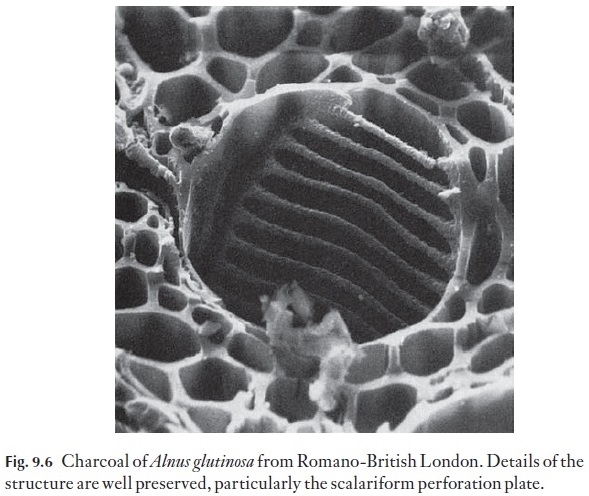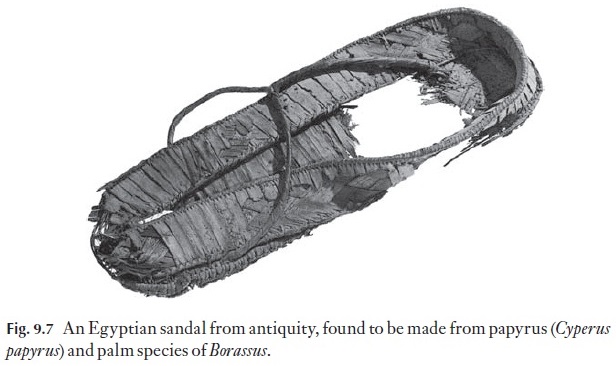Chapter: Plant Anatomy:An Applied Approach: Economic aspects of applied plant anatomy
Wood: in archaeology
Wood: in archaeology
Wood or charcoal is often preserved in sites from antiquity. The best pres-ervation occurs in localities which are either very dry or continuously wet. Fluctuating drying and wetting encourages the activity of microorganisms and/or insects and can lead to the rapid decay of wood.
Charcoal, usually in the form of fire ash or the burnt remains of structur-al posts in post holes, often retains even very delicate features of vessel ele-ment wall pitting and perforation plates. Figure 9.6 shows Romano-British Alnus charcoal. It can be difficult to see details of the anatomy on first exam-ination of the surface of a piece of charcoal, because it is often damaged and dirty. After a period of drying in an oven at 50ºC, the charcoal will fracture readily. If care is taken to snap it along the radial longitudinal, tangential longitudinal and transverse planes, good surfaces for study can be pro-duced. The specimens are mounted in plasticine or blue-tack on a micro-scope slide, and examined under the epi-illuminating microscope.

We have tried embedding and sectioning charcoal (with a diamond saw), but so much material is lost in the process that it was found not to be worth-while. The very small fragments can be examined in the SEM, after coat-ing, but generally the light microscope is adequate.
It can be determined if the makers of the fire had selected particular woods for their burning properties, or if the remains merely represent what was growing locally and easily accessible. Moreover, an idea may be gath-ered about the composition of the vegetation of an area at particular times.
Some sites are very rich in waterlogged or dry, preserved wooden objects. The Sutton Hoo burial ship, for example, contained many wooden grave goods. Interesting examples from this site are some small pots with silver gilt rims. On excavation these were thought to be made from small gourds, fruit from the Cucurbitaceae. Microscopical study of thin sections showed the structure to be of walnut wood, probably from near the rootstock, where burr-wood could be obtained.
With improved techniques for recovering wooden wrecks and, subse-quently, conserving them by special impregnation techniques, interest has increased in naval architecture.
The timbers of a warship from the Punic wars were remarkably well preserved and were readily identified after many centuries in sea water. An oak Iron Age boat from Brigg in South Humber-side also proved to be fascinating. No ‘nails’ were used to secure one timber to another, but the main logs were sewn together with twisted willow twigs passed through regularly pierced holes along the edges of the baulks of tim-bers In the Bronze Age, trackways were built across swampy ground in Somerset. The hazel faggots (Corylus) used in these were well preserved in the waterlogged conditions. We look at archaeological material from all sorts of wooden objects: spear shafts, shields, buckets, right through to structural timbers. Much of this work is very time-consuming. Often some details of the anatomy are lost, and very careful comparisons with reference materials need to be made before identifications are given Because of the potentially enormous quantity of fragments of wood that could come from even one fire, it is sensible to sort them visually into groups and limit the initial sampling to some examples from each group.
Wood products
Archaeological plant remains other than from wood can sometimes be re-markably well preserved. The sandal shown in Fig. 9.7 from ancient Egypt is such an example. Cyperus papyrus is a major constituent of the sandal, and

someBorassus (palm) is also present). However, some of the samples are waterlogged and compressed. It is often possible to ‘revive’ such material. The secret is to section it in the compressed form and revive the sections, by floating them briefly in sodium hypochlorite solution or in chlor-zinc-iodine. Temporary mounts are best made in 50% glycerine.
The structural properties of wood are utilized in modern building meth-ods by using not only solid timber, but also laminates, plywoods, chip-boards, hardboards and the like. These materials are tested to destruction so that their properties can be properly evaluated. Microscopic examina-tion of the failure areas can give a good guide to areas of weakness.
Related Topics